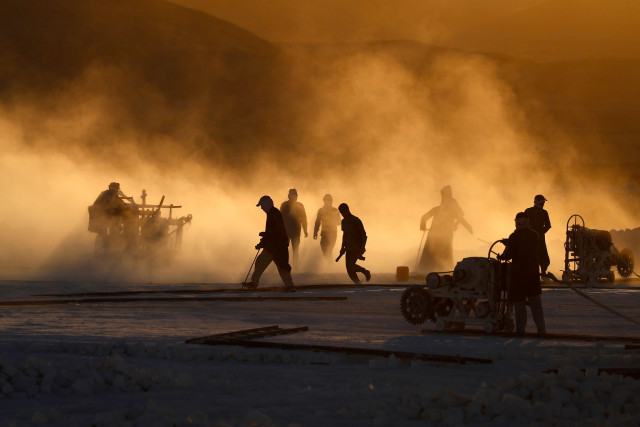Thar: Potential for new power, fuel, urea projects
There is need for developing policy to produce these products from coal

PHOTO: AFP
While there is nothing new about electricity from Thar coal as one project is already in production and several others are at various stages of implementation, projects of fuel and fertiliser production are new and a welcome development.
Apart from the Oracle project, Chinese companies are on trips to Karachi and Islamabad to explore and discuss such projects.
Fertiliser production with the help of Thar coal and gasification thereof is being debated for a long time in Pakistan. There are, in fact, a variety of products including gasoline, diesel, gas and different chemicals that can be produced out of coal.
Syngas is produced by burning coal under high pressure and temperature with low oxygen. There are then two routes – one is Fischer-Tropsch process under which syngas is converted into gasoline and diesel, and the other is a more versatile methanol route in which syngas is converted into methanol and then there are wider possibilities of producing gasoline, diesel and chemicals including plastics base material.
There has been, however, considerable scepticism about the suitability of lignite for gasification. It has been successfully proved in China and the US that lignite (Thar coal type) can be gasified and subsequently converted into various products such as fertiliser, gasoline, diesel and chemical products.
In case of urea, fertiliser plants are located far away from Thar coal fields as the closest are 400 km away on Sindh and Punjab borders. Either syngas has to be transported there, which is not easy, or fertiliser plants may have to be shifted from their present locations to Thar or coal may have to be transported to the fertiliser plants at their existing locations in Sindh.
The latter may be a costly operation adding $20 per ton to the coal cost, which is already high under the current production scheme in Thar. However, new urea fertiliser plants can be installed without such problems.
Negotiations are going on for producing diesel from Thar coal. China has been producing diesel from coal since 2008. Financial Times reports production cost of converting coal into diesel in China at $446 per ton as opposed to the spot diesel price of $578 per ton, which shows a 23% cost advantage.
Reportedly, Sasol (South Africa) is producing even at a lower cost. According to a Chinese publication, coal to diesel is feasible at $50 per barrel of crude oil prices. Current Brent crude price is $64 per barrel.
About 3.5 tons of coal (sub-bituminous probably) is required to produce one ton of diesel. Thar coal CV is on the average half that of normal coal.
Pakistan’s annual diesel demand is 7.2 million tons. There should be good chances for developing a feasible project for producing one to two million tons of diesel per year, meeting 20% of the annual requirement. By comparison, a 200,000-barrel-per-day oil refinery produces five million tons of diesel.
Methanol production
Methanol can also be the initial product at the Thar site, having physical and technical feasibility whereas economic feasibility calculations are awaited. China is the largest consumer of methanol globally, consuming seven million tons annually. China is a net importer despite a considerable local production.
Thus, there is scope for designing an export-based methanol project on Thar coal. Other products such as urea, gasoline and diesel may be added later. Methanol can be converted into gasoline as well under an ExxonMobil MTG process.
Simply speaking, methanol (CH3OH) is a colourless liquid form of methane (natural gas). It is the simplest form of industrial alcohol being used both as fuel and chemical input.
Methanol has many applications. It is safer than liquefied petroleum gas (LPG) gasoline and diesel. Its risk rating is 15 vs 36 for LPG. Its (M15) emissions are also lower than RON-95 gasoline. Methanol is non-pressurised unlike LPG.
It can be mixed into LPG with a 20% share to make LPG cheaper. It can replace LPG altogether, or to the extent LPG is imported. More than 500,000 tons of LPG is imported annually.
Methanol can also be mixed with gasoline as an octane enhancer in place of injurious metallic compounds based on manganese. Methanol can be added to gasoline in the proportion of 12% to be marketed as M15 gasoline. Methanol can replace diesel in modified truck engines.
Another application is in marine transportation, where methanol can replace dirty furnace oil. In China, all such applications are being utilised. India and Egypt have launched projects for M15 gasoline and LPG mixing. Methanol is cheaper than LPG and gasoline. The current spot price of methanol is $1.03 per gallon vs $1.65 per gallon for gasoline at the New York Mercantile Exchange. Diesel is priced at $586 per ton vs methanol at $342 per ton.
However, it has to be noted that one litre of methanol is thermally equivalent to 0.65 litre of gasoline. It can be manufactured from a wide variety of raw material like biomass, natural gas, oil, coal and various wastes.
In Pakistan’s case, it would save foreign exchange, if nothing else – if local methanol production is even equal to gasoline or diesel prices. Comparative cost calculations are to be done.
Synthetic natural gas (SNG) appears to be a possible option due to the location and transportation issues. It is, as the name implies, is natural gas but is produced synthetically as opposed to being dug out from gas fields. It is methane (CH4) as opposed to syngas (a mixture of CO, H2, CH and others).
Chinese are facing similar problems with their coal and lignite resources buried in the Mongolia desert. A number of SNG projects have been implemented and more are in the process.
Following production possibilities may be considered: methanol 1.4 million tons per annum, SNG 600 million cubic feet per day (mmcfd), urea one million tons per annum and diesel one to two million tons per annum.
Individually, these quantities may not be very high but when combined this may become quite a large volume. The integrated power and petroleum/chemical products production may offer many opportunities of cost reduction, especially, through the utilisation of waste heat, improving yield and thermal efficiency.
However, the capital expenditure requirements would be high. Individual coal projects of 1,320MW have a capital expenditure of $2 billion each.
Chinese cooperation
These are capital and technology-intensive projects having longer gestation periods. Many companies may not be interested. Such projects may only be financed through Chinese cooperation under CPEC or otherwise.
There is no free lunch. Investors expect good return. It has to make economic sense for the recipient as well. It is hoped that competitive, fair and mutually beneficial project schemes will be worked out eventually.
Fortunately, for traded goods like methanol, gasoline and diesel there are known international prices around which agreements are possible. Even gas has become tradable in the form of LNG.
The weighted average import price of LNG in Pakistan is estimated at $7.5 per mmbtu and local gas at around $6 per mmbtu. Concluding, there is a need for developing some kind of a policy. However, it is good to see interest and activity. Let this does not wane away.
The writer is former member energy of the Planning Commission
Published in The Express Tribune, December 16th, 2019.
Like Business on Facebook, follow @TribuneBiz on Twitter to stay informed and join in the conversation.



















COMMENTS
Comments are moderated and generally will be posted if they are on-topic and not abusive.
For more information, please see our Comments FAQ